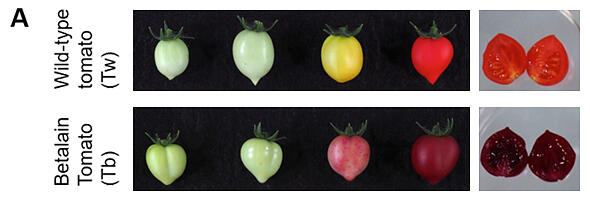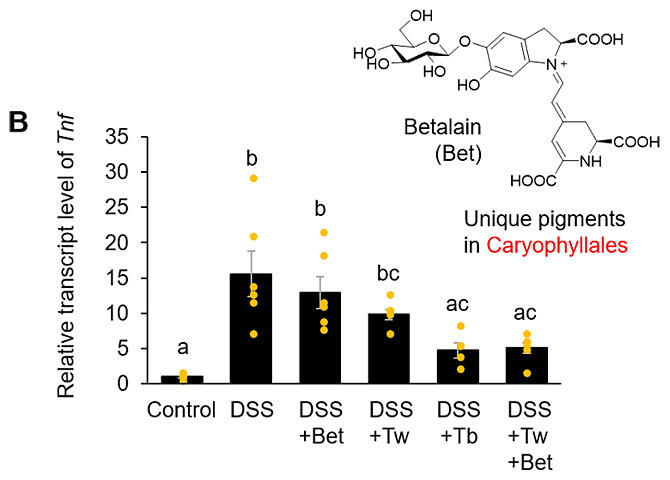The research group of Professor Gen‐ichiro Arimura of the Department of Biological Science and Technology, Faculty of Advanced Engineering, Tokyo University of Science, in collaboration with Iwate Biotechnology Research Center, announced that they have successfully generated tomato and potato plants that produce the betalain pigment betacyanin, a strong antioxidant, in their fruit and tubers. Betalain, which is found only in Caryophyllales plants and has low heat resistance, could be useful if expressed in tomato, a vegetable that is usually eaten raw. The results were published in Biotechnology and Bioengineering, an international academic journal.

Provided by Gen‐ichiro Arimura from Tokyo University of Science
Betalain pigments include red‐purple betacyanins and yellow betaxanthins, which are found naturally only in Caryophyllales plants, such as beet. Betacyanins from beets have long been used as natural coloring agents for sweets and confectionaries. Recent studies have shown that betalain's strong antioxidant activity is expected to be useful as functional components for their health‐promoting effects. Recombination experiments have shown that betalain imparts antibacterial activity to plants.
However, the utilization of betalains in health‐promoting foods has not yet been reported. To address this gap, Arimura's research group introduced betalain biosynthesis genes into tomato and potato plants to induce pigment accumulation in their fruit and tubers and then verified its anti‐inflammatory effects in mice.
Three genes (CYP76AD1, DOD, and 5GT) are involved in betacyanin biosynthesis. Betacyanin‐producing tomato (Tb) and potato (Pb) strains were engineered by introducing these genes into wild‐type plants using suitable promotors. When the plants matured, the stamens of Tb strains changed to orange or red, and the fruits turned dark red. The roots and tubers of Pb plants turned dark red, and the leaves were slightly darker than those of the wild‐type plants. The edible parts of these Tb and Pb plants had high betacyanin content.
In tomatoes, betacyanin accumulates during fruit maturity. To investigate the anti‐inflammatory effects of tomato and potato with accumulated betacyanin, experiments were conducted in which the edible parts of Tb and Pb plants were pulverized and extracted, and the extracts were added to macrophage‐like cells.
Dilutions (100‐1000‐fold) of the extract were added to macrophage‐like RAW264.7 cells. The cells were activated by lipopolysaccharide (LPS) treatment. Then, the transcript levels of various inflammation‐related genes were measured. Transcript levels of the inflammatory cytokine TNF‐α were significantly decreased in cells treated with either dilution of the Tb plant extract. Transcript levels of two other inflammatory cytokines (IL‐1β and IL‐6) and the inflammation‐inducing gene COX‐2 were also decreased.
In contrast, for potatoes, an extract of neither the Pb nor wild‐type strain induced a decrease in the transcript levels of these genes. When a similar experiment was conducted using a commercially available beet red dye (BR) containing betacyanin, transcript levels of TNF‐α were decreased at concentrations of 1 nM or higher.
To examine their effects on colitis, Tb, wild‐type tomato (Tw), and commercial BR were orally administered to mice for 11 days, and colitis was induced by sodium dextran sulfate treatment. Colitis‐induced weight loss was significantly less in Tb extract‐treated mice than in Tw extract‐ and BR‐treated mice, and the disease activity index (DAI) scores were significantly better in Tb‐treated mice. Colon shortening and increased TNF‐α transcript levels induced by inflammation were decreased. In contrast, Tw‐ and BR‐treated mice showed no such suppression.
Weight loss and colonic shortening were slightly or moderately improved by administering wild‐type tomato extract, which may be attributed to other functional components in tomato, such as lycopene. The researchers subsequently examined the synergistic effect of Tw fruit‐derived ingredients and betacyanin. Tw extract was mixed with BR (Tw + BR), and similar experiments were conducted to compare its effects to those of Tw alone.
The results showed that Tw + BR reversed weight loss and colon shortening to the same extent as Tw or BR alone. In contrast, Tw + BR improved the DAI score to the same extent as Tb. Tw + BR suppressed transcript levels of TNF‐α to the same extent as Tb. These results indicate that tomato fruit‐derived components and betacyanin exhibit partially additive or synergistic anti‐inflammatory effects. The engineered tomato is expected to be produced as a healthy food in a closed plant factory.

Provided by Gen‐ichiro Arimura from Tokyo University of Science
Arimura stated, "In this study, we analyzed the anti‐inflammatory function of betalain, a pigment unique to Caryophyllaceae plants like table beet, and observed a strong antioxidant effect. The pigment could be beneficial for many diseases, and we will examine its functionalities in future studies."
Journal Information
Publication: Biotechnology and Bioengineering
Title: Metabolic engineering of betacyanin in vegetables for anti‐inflammatory therapy
DOI: 10.1002/bit.28335
This article has been translated by JST with permission from The Science News Ltd. (https://sci-news.co.jp/). Unauthorized reproduction of the article and photographs is prohibited.




